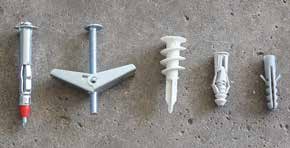
By Julie Peri–
The first step for hanging a picture or artwork on a wall is knowing what material your wall is made out of. Most walls are either drywall or plaster. Drywall is made of gypsum in between two sheets of paper that are attached to the studs of the wall. Plaster walls are created by attaching lengths of wood to the studs of the wall and applying several coats of plaster over the top. Plaster is more common in older homes, drywall in newer homes.
Drywall is softer and thinner than plaster walls, and nails can be hammered into drywall without usually causing damage. Plaster is more brittle and can crack or chip, so you will always want to pre-drill a hole in the plaster before adding any hardware, such as a nail, screw, or anchor.
When hanging artwork, your best bet is to find a stud to drive a nail or screw into. Studs often can hold up to 100 pounds regardless of your wall type. If you can’t use a stud, you will want to use an anchor and screw. If you don’t use an anchor, the screw will pull out. Each anchor and screw can hold up to 20 pounds, so if what you are hanging weighs more than that, you can use two anchored screws to support the weight.

The type of anchor you use will be determined by the type of wall you have. For drywall, you can use a drywall anchor or a toggle bolt. A drywall anchor is typically plastic with a split at the bottom that expands out as you add the screw, keeping the screw secure in the wall. A toggle bolt is a bolt with metal hinged wings around it that folds in one direction to go into the pre-drilled hole in the wall and opens once through the hole to brace against the back of the wall. This type of anchor can hold up to 40 pounds.
Drilling into plaster requires a little more care and consideration. You always want to pre-drill your hole, regardless of the type of fastener you are using and if your fastener is going into a stud. You can put a piece of tape on the plaster before drilling the pilot hole to prevent cracking. If you are not drilling into a stud, you will use anchors that are specially designed for plaster because plaster walls are typically much thicker than drywall, so drywall anchors will likely pull out of the plaster.
There are some plastic anchor options that work well for plaster called expansion anchors. Expansion anchors expand to grip hard, brittle masonry, which has a consistency similar to plaster. You can also order specialized plaster anchors, toggle bolts, or molly bolts. A molly bolt is a bolt with a metal sleeve around it. When it is inserted into a pre-drilled hole and tightened, the sleeve expands, bracing it against the back of the plaster and lathe.
We hope you enjoyed this tool tip. Join us for more fun tips at our workshops!
Introduction to Tools Workshop, November 20, San Francisco
Introduction to Tools Workshop, December 11, San Francisco
For more information about these and other events, go to: https://www.dykeswithdrills.com/workshops
Julie Peri is the Founder and Director of Dykes With Drills. https://www.dykeswithdrills.com/
Published on November 4, 2021
Recent Comments